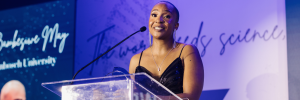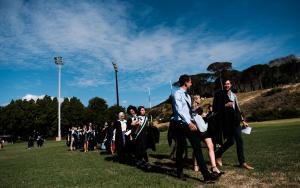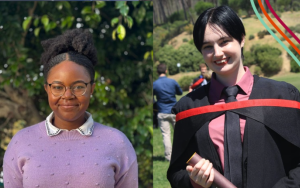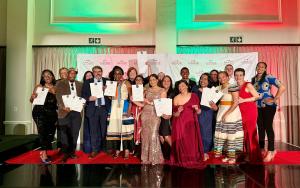
Dr Bambesiwe May receiving the L’Oréal-UNESCO For Women in Science Award.
L’Oréal-UNESCO award for SU researcher tackling mining waste challenges
- Dr Bambesiwe May won a L’Oréal-UNESCO For Women in Science Award.
- She develops sustainable frameworks to manage mining waste.
- Her work reduces environmental risks and makes the industry more sustainable.
“I was excited, grateful, and honestly just overwhelmed with joy. It felt like a ‘finally’ moment, like all the quiet seasons of persistence had found their recognition. It was an amazing feeling, both grounding and surreal at the same time.”
This is how Dr Bambesiwe May, a postdoctoral fellow at the African Rainbow Minerals Chair in Geometallurgy in the Department of Earth Sciences at Stellenbosch University (SU), reacted upon hearing that she had won a research grant as part of the prestigious L’Oréal-UNESCO For Women in Science National Programme. She was one of eight women recently honoured at an award ceremony hosted by L’Oréal South Africa in partnership with UNESCO in Sandton, Johannesburg.
These awards celebrate outstanding women scientists who are using their research to help address some of Africa’s most pressing challenges. The national programme seeks to address the significant gender gap in science by fostering diversity and excellence in South Africa, by providing financial support and recognition to empower women scientists, acknowledging their crucial role in advancing scientific research and innovation.
May was honoured for profiling mining waste, which is often seen only as an environmental problem yet it can also contain valuable metals and minerals. She developed a framework that combines environmental risk management with resource recovery, helping us identify what can be reused safely and what must be contained. May is currently applying it to manganese and gold tailings (the leftover waste materials from mining after manganese or gold has been extracted from the ore) in Southern Africa. The goal is to turn waste from a liability into an opportunity.
According to May, her previous job sparked her interest in this area of science. “I worked as a geochemist in environmental consulting, where we constantly dealt with mine waste assessments and informing environmental impact assessments. I often found myself wondering, ‘What if we could do more than just classify waste? What if we could rethink it?’.
“But in consulting, time and scope don’t always allow you to explore those ‘what ifs’. So, I went back into academia, driven by curiosity and a desire to solve problems I had seen first-hand. I’m particularly inspired by problems because they energise me. I love creating practical, science-based solutions that protect nature and make industry more sustainable.”
May says the award feels like a validation of the journey – not just hers, but that of every woman who has kept going even when it felt invisible.
“Professionally, it’s a powerful reminder that the kind of work I do, bridging chemistry, geology and sustainability, matters. It opens doors for new collaborations and gives visibility to the idea that science can be both rigorous and socially responsive.
“I hope it reminds young women that there’s no single path into science and that curiosity is a powerful compass. You don’t have to have it all figured out; just start where you are, with what you have. I want them to see that science is not abstract; it’s human, creative and full of opportunities to make a difference. If my journey shows anything, it’s that your ‘why’ can evolve, but your impact deepens with every step you take.”
Knowing that her work is contributing to solving real-world problems keeps her going, adds May. She is deeply motivated by those who went before her and enjoys being around people she can learn from.
“Sometimes, motivation also comes from reflection, looking back at how far I’ve come, the hurdles I’ve overcome, and realising that this fuels me to keep pushing boundaries and to remain curious about what more is possible.”
With theL’Oréal-UNESCO For Women in Science Award under her belt, May will focus on piloting her Environmental Geochemical Assessment-Valorisation Framework across different waste streams. She will now apply it to other materials like water hyacinth, which they’re converting into paper, and textile waste to produce eco-friendly tiles. These projects all test how waste can be reclassified as a resource while protecting the environment.
May is also passionate about science communication and plans to share her work with the public. “I want to ensure relevant stakeholders are aware of what researchers are doing to solve real-world problems. Our discoveries shouldn’t remain buried in books and journals but reach the people and sectors that can act on them.”



